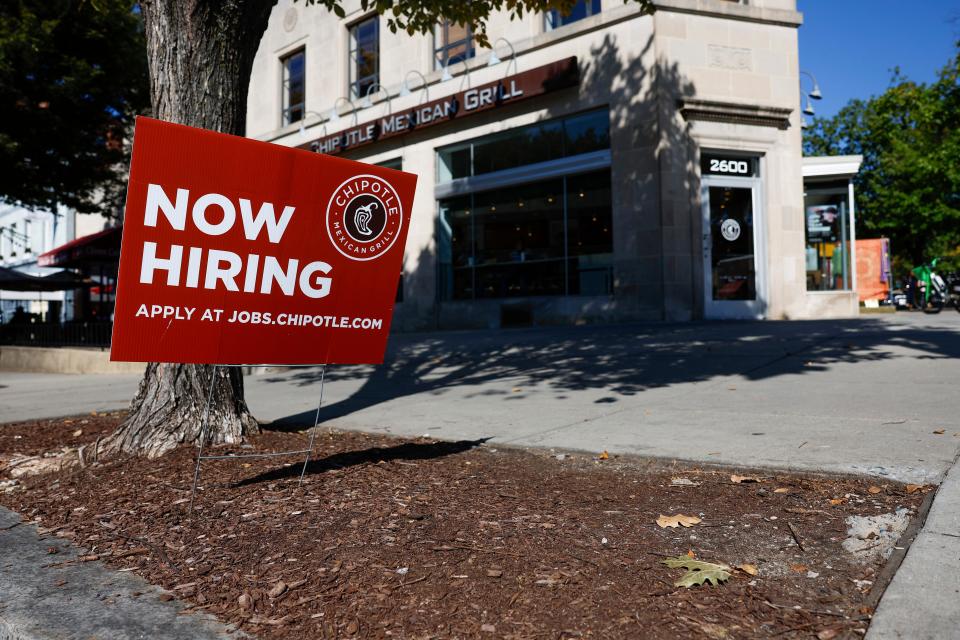5 signs the job market is cooling despite the blockbuster May jobs report
The May employment report, released Friday, appeared to show the nation isn’t close to tipping into recession with employers adding a booming 339,000 jobs.
Beneath the surface, however, were signs the labor market is softening as the unemployment rate rose sharply and the average work week declined to a three-year low.
"Under the hood, things are not as buoyant as the headline suggests," economist Bob Schwartz of Oxford Economics wrote in a note to clients. The mixed messages present a conundrum for a Federal Reserve wrestling with whether to pause its aggressive flurry of interest rate increases this month or continue to hike rates to cool the economy and, more critically, inflation.
Capital Economics is among several top research firms that believe the report contains enough signals of emerging weakness for the Fed to skip a hike at its upcoming meeting and see how the economy evolves, especially with banks toughening lending standards after the collapse of several regional banks.
Among the signs of a flagging job market:
Worker shortages and the South Is there a labor shortage? It's easing in most places, but not much in the South. Here's why.

What is the current unemployment rate?
May’s unemployment rate jumped from a five-decade low of 3.4% to a still healthy 3.7% as employment declined by a net 310,000 jobs, according to Labor’s household survey.
The jobless rate is based on a survey of 60,000 households and is generally considered less reliable than the poll of 122,000 business and government agencies that produced May’s headline job gain of 339,000.
Also, the pullback in payrolls in the household survey can be traced to a big drop in unincorporated self-employed workers, a decrease that the survey of establishments doesn’t capture, says economist Dante DeAntonio of Moody’s Analytics,
Still, the household survey shows nearly 2 million fewer workers overall than the establishment survey, Barclays notes, reflecting a longer-term disparity. And economists say the household survey is generally better at highlighting turning points in the economy and labor market, such as when the economy is heading toward a recession.
Are bumpie flights due to climate change Climate change is making turbulence worse, but here's why you shouldn't worry (too much)
What is the most common work week?
The average number of hours U.S. employees worked dipped from 34.4 to 34.3 in May, the lowest level since the early days of the pandemic in April 2020. That shows consumer demand may be easing but employers are opting to hold onto workers – a practice known as labor hoarding – because of persistent COVID-related worker shortages the past couple of years, Bank of America suggests. Instead, they're trimming the hours of existing employees.
But that practice can go on only so long if sales and profits don’t pick up. The earnings of S&P 500 companies fell 2.1% in the first quarter, the second straight quarterly decline, according to FactSet.
What is current wage growth?
Average hourly earnings increased 0.3% in May, a slowdown from the 0.4% rise the prior month. That shows wage pressures are easing as employers’ bargaining power strengthens in a cooling market, Schwartz says.
A big reason for that is the share of Americans in their prime working years (age 25-54) who are employed or looking for a job edged up to 83.4% last month, the highest since May 2002, according to Oxford and Labor figures. More people sidelined by COVID for health or child care reasons have filtered back in to the work force.
What's in that carry-on bag? Can I bring this on a plane? Weird stuff TSA will let you fly with from antlers to hookahs.
Is it harder to get a job if unemployed?
The share of unemployed workers finding a job fell to 25.8% last month, the lowest level since August 2021, data from Oxford and The Liscio Report, a research publication, show. In other words, businesses are hanging onto the workers they have but they’re becoming warier about bringing on new employees.
Nostalgic for prefab homes? Sears pioneered the modern prefab house in the early 20th century: Look back at 'kit homes'
How long do most people stay unemployed?
As a result, jobless workers are idled longer. The average duration of unemployment increased for the third straight month, from 19.3 weeks in February to 21.2 weeks in May, according to Oxford and Labor figures.
This article originally appeared on USA TODAY: The job market may be slowing despite booming gains in May

 Yahoo Finance
Yahoo Finance 